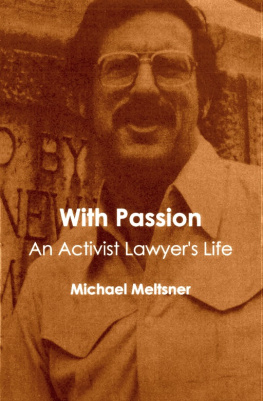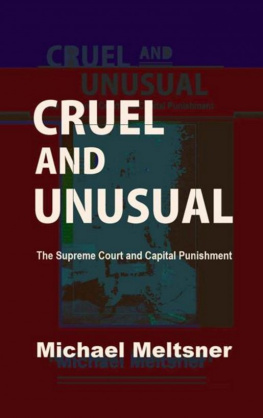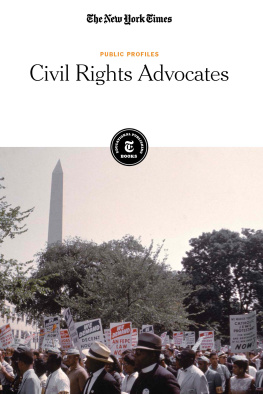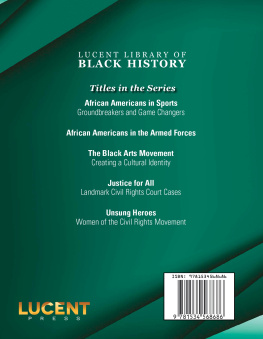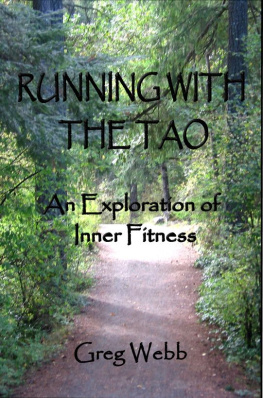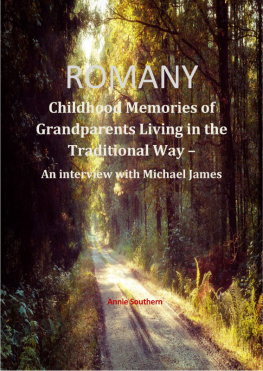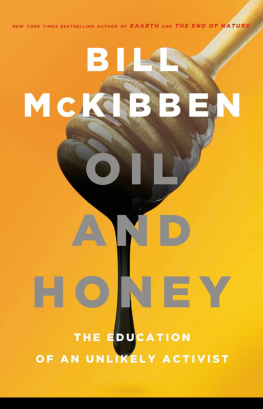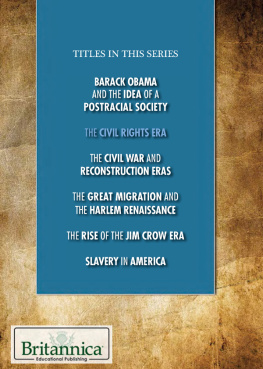About the Author
Michael Meltsner is the George J. and Kathleen Waters Matthews Distinguished University Professor of Law at Northeastern University. He was first assistant counsel to the NAACP Legal Defense Fund in the 1960s, arguing many leading civil rights cases before the federal courts. From 1970 to 1979 as a professor of law at Columbia Law School, he cofounded the schools first clinical program. He served as the Northeastern dean from 1979 until 1984. His memoir, The Making of a Civil Rights Lawyer , was published in 2006. Among his other writings are: Cruel and Unusual: The Supreme Court and Capital Punishment; Public Interest Advocacy and Reflections on Clinical Legal Education (both with Philip Schrag); and Short Takes , a novel. His most recent book, Rape, Race, and Injustice , tells the story of a group of law students sent secretly to the South during the 1960s to collect proof of sentencing discrimination. His 2011 play In Our Name: A Play of the Torture Years has been performed in New York and Boston. He has been a Guggenheim Fellow and has served as a consultant to the Department of Justice, the Ford Foundation, and the Legal Action Center and has lectured in Canada, Egypt, Germany, India, the Netherlands, and South Africa. In 2000, he was named a fellow of the American Academy in Berlin. From 2000 to 2005 he was a visiting professor and director of the First-Year Lawyering Program at Harvard Law School. In 2010, he received the Hugo Bedau Award for excellence in death penalty scholarship. Calling him... the principal architect of the death penalty abolition movement in the United States, in 2012 he was awarded an honorary doctorate by John Jay College (CUNY).
Acknowledgments
Ultimately the stories we tell ourselves about who we are and where weve gone amount to best guesses. Knowledge mysteriously layers itself into character and shapes experience or the process, equally tentative, equally opaque, works in reverse. For me fortunately the relationships that have emerged are undeniable, vivid, and concrete. I couldnt have written this book much less lived much of the life it traces without the intense presence of my wife, my two daughters, Jessie and Molly, their children and spouses. As a young man, I believed in the dominance of personal autonomy but proof of its jacketed confines is confirmed by the number of those who helped, wittingly or otherwise, bring the book to rest. I mention but a few of the many. My great thanks and gratitude to Anthony Amsterdam, Roger Abrams, Matt Berger, Margaret Burnham, Brandon Garrett, Randall Kennedy, Evan Mandery, Daniel Medwed, Herb Sturz, Patricia Wald, Mark Morrill, Carol McGeehan, Victor Navasky, Dorothy Samuels, Philip Schrag, Carol Steiker, Rose Zoltek-Jick, and Margaret Woo. Library and computerrelated support was exceptionally provided by Jackie LaCorte, Diane Dalmeida, Alfreda Russell, and Keith Wise. Special thanks to the Editors at Twelve Tables Press and Publisher, Steve Errick.
I owe a great debt for the decades-long friendship of Stanley Fisher and the late Harry Subin. Their laughterand examplehas kept me going through many a rough patch.
Authors Note
This is not a work of fiction. Names, characters, places, and incidents, including references to legal matters, are not products of the authors imagination and are not to be construed as fictitious or as composites of various realities. The depiction of events, locales, organizations, or persons living or dead is intended to be an accurate representation of what actually occurred. Occasionally, the text contains material that I have published elsewhere but which seems appropriate to include here. Wherever possible, documentary and other historical sources as well as interviews have been consulted as a check on memory but should readers have a contrary view be assured that the systematic clash of interests that characterizes our politics (and our legal system) supports the presence of different stories, voices, and points of view.
War
Wars are not accidents in history, but integral and even normal parts of the process of history.
(James Burnham)
I go to New York City now as a visitor. Brutality that once thrilled me is now too often a chaos of noise, dirt, and ugliness, although some of this is times wicked distortionthe redoubtable Jim Dwyer wrote recently in The Times that in the 1960s you could touch the air in New York. It was that filthy. No sensible person would put a toe in most of the waterways. Still a world where the poor had some purchase, weak as it was, now favors only the moneyed. It was my grandmother who gave these feelings permission, as James Salter would put it, born to the city and thus free not to love it, but when I was a citizen pride, even arrogance, overrode the critic.
No matter where I am, the City is with me always, folded into the daily fabric of my life. Dodgers and Giants could escape; I never could. In the seacoast town where I have spent part of over fifty summers, there is a large shore-side granite quarry, once in private hands but now part of a popular state park. A bizarre conglomerate structure looks down at the dazzling blue rainwater that fills its depths, long ago the source of building foundations and curbstones in Manhattan and San Francisco and later, after reinforced concrete doomed the granite trade, the best swimming hole in a hundred miles. My eye travels from the suggestion of a Dutch gambrel-style house to an ugly five-story concrete tower said to have been the site for an antiaircraft weapon guidance system during World War II. Above the tower sits a frame cupola that looks like it could have been lifted from a salvage yard specializing in demolished churches. Glancing up at it while I jog on the gravelly path that circles the quarry, I wonder what its designers could have been thinking: I conclude only a committee of bureaucrats could have produced such improbability.
The house is now a visitors center and an exhibit gives up the answer. In an effort to camouflage the towers function from the air, military planners placed the fantasy of a gabled cupola as might top a New England Congregational Church above the flat roof of the tower. Whatever the illusion fostered in the mind of a Nazi reconnaissance pilot banking his aircraft to get a look, assuming any German aviator ever made it to this coast, the view from the ground today probably reminds visitors more of a Disneyland concoction than a national defense asset. On my way down to the nearby seaside path, I never take in this remnant of years increasingly few remember without being reminded of the whitewashed gun emplacements set out to protect us from enemy invasion as they lined the fringe of the beach in the Rockaway neighborhood of Queens, New York, where I lived until age twelve.
For what to him were totally mysterious reasons, and a constant embarrassment, my father was rejected for military service in World War II by the local draft board. Because he felt he had to do something to support the war effort, he volunteered as an air raid warden. Proudly donning what looked like a white construction workers hard hat and carrying a chrome-cased flashlight, many nights he walked our street from one end to the other, from Jamaica Bay to the boardwalk facing the Atlantic Ocean, calling out when he saw shafts of light from only partially darkened houses: Pull those shades all the way down. Please dim those lights.
Or more stridently: Air Raid Warden. We are by the ocean. Kill Those Lights!
His voice carried over the insane buzzing of the cicadas to my bedroom in the tiny house near a sandy lot my parents had bought for $5,000 shortly after I was born. It was strangely comforting to hear him call out in the night even when he varied the injunction with a scary warning like, Remember those U-boats. I knew what a U-boat was because I had seen a picture of a submarine in the World-Telegram , one of the many newspapers he brought home from his work an hour train ride away in Manhattan.

